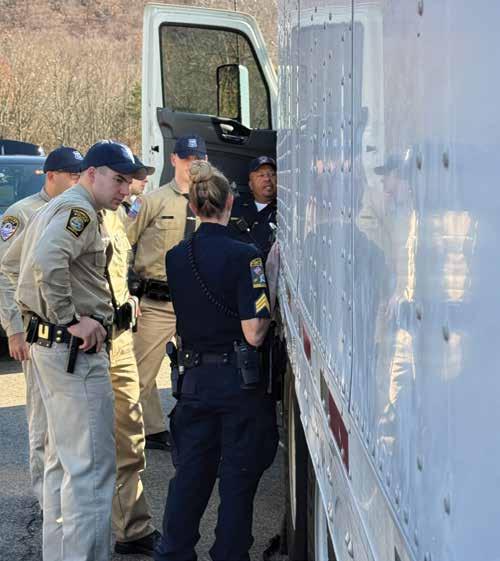
3 minute read
Connecticut Introduces New Recruits to Commercial Motor Vehicles
By Sgt. Jaclyn DeVore, Connecticut Department of Motor Vehicles
How are states implementing commercial motor vehicle (CMV) education to promote safer roadways?
Connecticut law enforcement is comprised of both state and municipal police departments. Unlike most jurisdictions, most of our state’s crashes occur on interstate highways. Only state officers are certified to conduct North American Standard Inspections, which creates a lack of information regarding CMV enforcement among municipal officers.
Crashes may be overrepresented on interstate highways, but we all know that CMVs travel on and require state and local roads for society to exist and function. Oil and propane trucks making deliveries to residences; UPS and FedEx making local package deliveries; triaxles and tractor-trailer units in combination making deliveries to local farms, factories and warehouses; and school buses transporting students to and from school are all examples of CMVs on local roads. Certified officers have statewide jurisdiction, but we also rely on our municipal/local officers to be aware of CMV hazards, respond to crashes and conduct enforcement, making education of local law enforcement officers paramount to ensuring public safety.
As part of law enforcement basic recruit training, all academy classes that attend the police academy are required to complete a four-hour block on CMV law taught by the lead agency. During this class, recruits learn about commercial driver’s licenses (CDL), endorsements and restrictions, as well as how Title 14 and Connecticut motor vehicle law can be applied when encountering an incident involving a CMV and driver.
This comprehensive class has two separate portions. The first half is a classroom presentation on the following topics:
• Public transportation endorsements
• Medical certificates
• Operating under the influence
• Hours of service/electronic logging devices/logbooks
• Registration and insurance
• Size and weight
• Parts and accessories necessary for safe operation
• Truck and bus crashes
• Load securement
• Behaviors indicative of human trafficking and drug trafficking
After completing the classroom portion, we escort the academy recruits outside, where a CMV is waiting for a hands-on demonstration on how to approach the CMV safely. The instructors go over basic approaches, what to look for in the cab, what documentation should be presented, basic safety violations that would warrant a further inspection/analysis of the driver or vehicle, vehicle identification tags, and trailer registration boxes/locations. The instructors also allow the CMV driver to interact with the recruits by providing positive feedback on his job as a CDL driver, which creates great public relations.
Together with the Connecticut Federal Motor Carrier Safety Administration field office, we developed a quick-reference visor card to make CMV encounters easier for municipal officers. These cards include a CDL flowchart, a QR code for endorsements, common CMV state statutes and a law enforcement-specific call line to our agency for additional support.
Teaching this class allows us to share pertinent information through classroom presentations, hands-on demonstrations and quick-reference visor cards. It also provides transparency and integrates state and local law enforcement efforts to reduce CMV crashes and ensure the safe travel of our families on Connecticut’s roads.










